A Growing Revolution – Two Great Books about Soil Life!
Welcome to our May 2017 SoilMatrix newsletter – A Growing Revolution – Two Great Books about Soil Food Web and Healthy Soil Function!
This month’s newsletter contains some valuable revelations gained from two books and two different authors who have keen insights into how to bring soils back to vibrant life and health through building into the “Soil Food Web”. I will share these with you after I describe and show you what is happening in the SoilMatrix Garden right now!
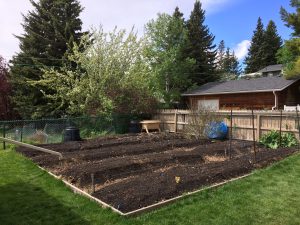
Soil preparation and seeding are complete for this year. I went out on a limb and purchased a couple of totes of good garden soil and a tote of Hop compost to blend along with about 25% (by volume) SoilMatrix Biochar. The additional soil was needed to expand the number of raised beds and I became impatient with attempting to do this out of my own soil stock. Here is what the seeded raised beds looked like at the end of the May long weekend (May 22, 2017). See photo above:
There are now five (5) three foot wide beds. The wooden box at the far corner is a bee hive. A rhubarb patch is in the right hand corner, the downspout from the house goes into one of the swales to store water during large rain events. The swales connect with each other and work nicely to create a bottom wicking function to keep the beds moist during longer dry periods.
I don’t cultivate or rototill the soil and it is usually covered with either wood chips or other organic material, but I prefer to seed into bare soil and wait until the seedlings begin to sprout before reapplying the mulch cover. However, this is a practice I plan to change after reading the first book I’ll mention this month – Jon Stika’s “A Soil Owner’s Manual”. In fact — Jon sent a reply to the SoilMatrix website last week to suggest that readers of The SoilMatrix Newsletter may be interested in his book. What an understatement! I read the book in about three or four sittings and plan to re-read it several times. This book is a thought changer for me. It describes in plain language how to restore soil’s capacity to perform all of its intended functions. Jon Stika is one of America’s soil health pioneers (we will learn from a number of these pioneers in future newsletters) and in simple terms he describes how to restore soil to its full potential by working with nature instead of relying on expensive inputs to maintain yields. I highly recommend this book and encourage you to read it carefully. It is available as a download from Amazon:
https://www.amazon.ca/dp/B01FFYD71Y/ref=dp-kindle-redirect?_encoding=UTF8&btkr=1
So at this point you must be scratching your heads thinking, what is the SoilMatrix Biochar guy saying here. Isn’t biochar a soil amendment? And didn’t he just say that a full 25% of the soil he just blended is SoilMatrix Biochar? Well yes, that is what I just said. And the truth is, if you do all the things suggested in Jon Stika’s book, you probably don’t need any biochar in your soil to make it healthy and productive. My hypothesis, however, is that soil can be made more healthy and resilient by adding biochar to the soil up to between 20 to 30% by volume. After that there is a significant diminishing return on adding any more biochar. Moreover, once you have this amount of biochar in a soil, it remains there for a long time — no further additions are necessary.
The second part of my hypothesis is that given the evidence from experiments where biochar is amended into soils in ways that work with nature and the soil food web, yields increase and nutrient input requirements reduce. How does this happen? It happens by biochar’s ability to stimulate microbial growth and then protect these beneficial microbes. Furthermore, biochar has the ability to make nutrients more bio-available for both microbes and plants. Future SoilMatrix Newsletters will share the results of numerous experiments that provide evidence of this. For now, let me just say that Jon Stika’s book has significantly changed the way I think about the soil and how the soil food web needs to be nurtured to perform as intended.
Let me demonstrate! After reading Jon’s book I have become more acutely aware of the function of earthworms in the soil. Earthworms are prolific in the SoilMatrix Garden. In the early mornings I have noticed something amazing appearing at the surface of our freshly seeded garden:
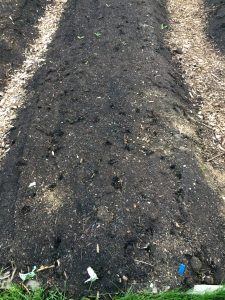
These earthworm burrows are literally all over. They also extend deep into each garden bed and serve to infiltrate water deep into the garden soil to preserve moisture and make it available to all of the soil matrix and roots. They also serve to keep the soil pliable and aerated so that the soil food web can breath and have much needed oxygen to function. But I have realized something else by observing these earthworm burrows… I need to replace the mulch cover as soon as possible to make sure my earthworms are properly fed. I am sure they come to the top of the soil for a reason. They are seeking organic debris to feed on and since I have removed most of it for seeding, it is missing. This photo shows what I have done to remedy this problem (see below).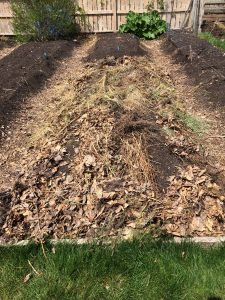
Not so pretty anymore, but it is far better for the soil to have a covering to protect it from the heat and heavy rains – to conserve moisture and to protect it from compaction. I am still careful to allow the seedlings to come through all this cover.
I hope to replace the mulch on the rest of the garden beds as soon as possible. This is a stretch for me because I am concerned about making sure the seedlings get a good start as well. In sum — it is an experiment for this year.
In the future, possibly starting this fall, I will be experimenting with cover crops on the SoilMatrix Garden. Based on Jon Stika’s book and based on the learning of thousands of no-till farmers, this is an even better option to loose organics on top of the soil. Why? Because of the additional benefit of roots for the soil. You will need to read the book to learn how cover crop roots add even more health to the soil.
Speaking of seedlings, here is an example of a zucchini seedling that I had to remove to thin the rows this morning:
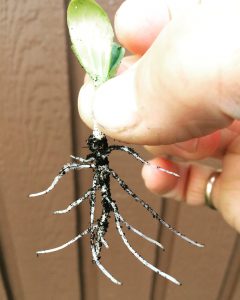
Notice the small flecks of biochar attached to the root hairs. This zucchini seedling was getting quite friendly with the biochar in the soil, but it’s not only the roots that benefit from the presence of biochar — have a look at a typical earthworm in The SoilMatrix Garden: 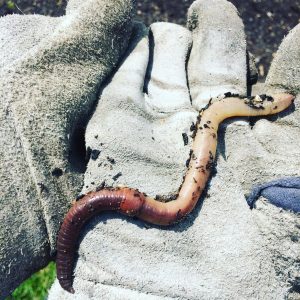
These are a set of my large work gloves to give you an idea of the size of these animals. I don’t need a rototiller with these guys working 24×7 to generate burrows all through the garden.
As of May 31, 2017 the garden appears as shown below. I’ll keep you posted as the summer progresses.
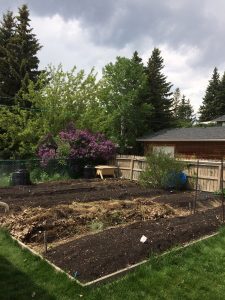 The second book that I am looking forward to reading more carefully ( I have scanned it quickly) is “Growing A Revolution, Bringing our Soil Back to Life” (May 2017) by Dr. David Montgomery. I have enjoyed two of his previous books:
The second book that I am looking forward to reading more carefully ( I have scanned it quickly) is “Growing A Revolution, Bringing our Soil Back to Life” (May 2017) by Dr. David Montgomery. I have enjoyed two of his previous books:
“Dirt, the Erosion of Civilizations”
and
“The Hidden Half of Nature, the Microbial Roots of Life and Health.”
These two books were game changers for me! They opened the door to understanding soils as living organisms (virtually the sum total of billions of mutually beneficial microbes and insects (arthropods, earthworms, etc.). However neither of these books discussed the potential for biochar amendments to further stimulate soil life and benefit plants. I chalk this up to the fact that experimental evidence for the benefits of biochar for soils has only become available in the past 15 years and these books were written at a time when this evidence was less available. All that has changed and Dr. Montgomery’s most recent book (Amazon link given below) covers this topic more fully.
These books and a growing number of people who are now lecturing and promoting the “Soil Life” proposition are nothing short of an ongoing revolution in North America and a number of other countries. Advances in microbiology, DNA mapping, and an understanding of the vast diversity of life responsible for how healthy soils function are moving this revolution along swiftly. Find Dr. Montgomery’s book here:
So that is it for this month. There will be a lot more to share as the garden progresses through the summer. Thank you for joining me on the journey of this growing revolution as David Montgomery phrases it.
Copyright ©_2017 AirTerra, All rights reserved.

Comments